|
The quest for the nearest inhabitable worlds
|
|
| apenpaap | Date: Saturday, 23.06.2012, 23:03 | Message # 1 |
 World Builder
Group: Users
 Antarctica
Antarctica
Messages: 1063
Status: Offline
| It's the year 2500. Over the past five centuries, humanity has spread across the Solar System. Almost every large world has at least a small population living on it. The United Planets has nineteen members by now; from the hardy miners of Mercury who provide most of the Solar System's metals and solar energy to the research colony on distant Triton. Yet of all these worlds, only a single one is easily inhabitable; it will take at least another three centuries before terraforming on Mars has progressed far enough for the surface to be inhabitable without the aid of at least an oxygen mask.
But all that is about to change as humanity is ready to set its next step into space. A gigantic ship for an interstellar journey has been made; ready to house 5000 adventurous colonists on the long journey to their new home, a journey they'll be taking at half light speed. Unfortunately most of the planets in the Alpha Centauri system were destroyed when a neutron star passed through that system in the 23rd century; so their most logical target isn't an option. Now it's our job to find them a planet to go to.
As mentioned before, they want to live their life without any aids from pressure domes, space-suits, underground bases, oxygen masks, etc. If that is what they wanted, they could've just gone to any of the worlds of our Solar System, after all. So we have to find the nearest planet to Earth that would be inhabitable to humans. (and, as mentioned before, Pandora nor any other world in Alpha Centauri counts) I guess the exact parameters of this world are very much up for debate, but here's my idea:
Star: any main sequence star; but the bluer the star the thicker the planet's atmosphere needs to be to hold back its UV radiation.
Planet class: Terra. Either with or without life.
Rotation Period: Preferably roughly 24 hours, but this isn't neccessary. Tidal locking seems a big no-no to me.
Axial Tilt: Below fifty degrees to prevent too extreme seasons.
Gravity: Between 0.25 and 1.5 g
Pressure: At least 0.5 atm when the sun is class M or K. At G or higher, atmospheric pressure needs to be higher too to protect from the sun's radiation.
Temperature: Highly depends on what the world looks like. On a world with great temperature differences, the acceptable range will be greater than on a world which looks like it has evenly spread temperatures (since a colony can be set up near the poles or equator, if neccessary)
Other: Things like extremely elliptic orbits are obviously a bad thing. Also, to ensure the air is actually breathable, the atmosphere should be blue like Earth's.
So there you have it. Let's try and find the nearest inhabitable world!
I occasionally stream at http://www.twitch.tv/magistermystax. Sometimes SE, sometimes other games.
Edited by apenpaap - Sunday, 24.06.2012, 12:05 |
| |
| |
| HarbingerDawn | Date: Sunday, 24.06.2012, 01:35 | Message # 2 |
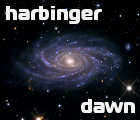 Cosmic Curator
Group: Administrators
 United States
United States
Messages: 8717
Status: Offline
| This star is in Amwhere's near stars addon, but since it's a real star I think it counts 
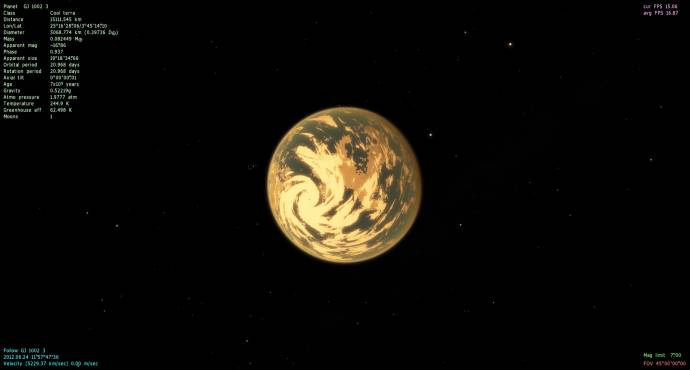
Distance from Sol: 4.69 pc
EDIT: I just noticed that you said no tidal locking, so sorry for posting this planet. But it seems to me that they could still settle somewhere where the temperature was temperate (close to the terminator). And the constant sunshine could be beneficial for growing crops. Settling a tidally-locked world doesn't seem an insurmountable challenge to me. But this is your challenge, so you set the rules 
All forum users, please read this!
My SE mods and addons
Phenom II X6 1090T 3.2 GHz, 16 GB DDR3 RAM, GTX 970 3584 MB VRAM
Edited by HarbingerDawn - Sunday, 24.06.2012, 01:41 |
| |
| |
| Solaris | Date: Sunday, 24.06.2012, 03:17 | Message # 3 |
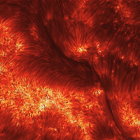 World Builder
Group: Global Moderators
 France
France
Messages: 731
Status: Offline
| Nice introduction apenpaap, !
I should grab the Amwhere's near stars addon, mine is 8.276 pc from Sol 
Maybe this tiny world could fit, It's a temperate terra Moon of a temperate desert in a binary red dwarf system, not the best option, but it's a start !
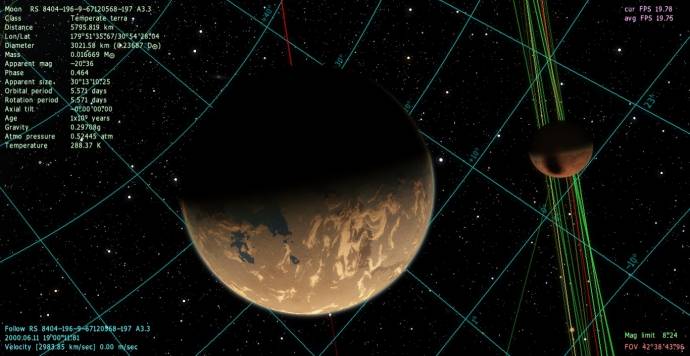
About tidal locking,
Quote (HarbingerDawn) But it seems to me that they could still settle somewhere where the temperature was temperate (close to the terminator). And the constant sunshine could be beneficial for growing crops.
Edit : I wonder what is the max atmospheric pressure that a human can survive in?
Edited by Solaris - Sunday, 24.06.2012, 04:07 |
| |
| |
| DoctorOfSpace | Date: Sunday, 24.06.2012, 05:01 | Message # 4 |
 Galaxy Architect
Group: Global Moderators
 Pirate
Pirate
Messages: 3600
Status: Offline
| If the year is 2500 why do humans even need to breathe oxygen? In fact why would there still be any sort of humans in the classical sense when a biological body is simply not fit for deep space life without carrying around bubbles of oxygen, radiation shielding, and supplies of food and water. I don't think extrasolar biological human colonization is ever going to happen, even by the year 2500. I suspect by that time technology will have changed man into more machine like organisms where DNA either no longer exists or has been replaced with a more efficient synthetic version. Already today the steps are being taken to replace organics with synthetics so I suspect by 2500 a human body would be comprised not of cells but individual nanobots that all work together and are all part of a neural network for a hyper intelligent being.
Tl;dr:
Any planet thats rocky(including ocean worlds) would be perfectly habitable for Earthlings in the future.
Intel Core i7-5820K 4.2GHz 6-Core Processor
G.Skill Ripjaws V Series 32GB (4 x 8GB) DDR4-2400 Memory
EVGA GTX 980 Ti SC 6GB
|
| |
| |
| apenpaap | Date: Sunday, 24.06.2012, 10:48 | Message # 5 |
 World Builder
Group: Users
 Antarctica
Antarctica
Messages: 1063
Status: Offline
| Quote (HarbingerDawn) I just noticed that you said no tidal locking, so sorry for posting this planet. But it seems to me that they could still settle somewhere where the temperature was temperate (close to the terminator). And the constant sunshine could be beneficial for growing crops. Settling a tidally-locked world doesn't seem an insurmountable challenge to me. But this is your challenge, so you set the rules smile
Well, the rules are wide open to everyone's own interpretation. The ones I posted were simply what I see as an inhabitable world. My logic for not thinking tidal locked worlds are a good thing is this: while the temperatures in the twilight zone might be temperate, there are still other problems. One of them are the constant blazing hot winds coming from the daylit side, which could be warm enough to be dangerous. Since the entire lit half of the planet essentially becomes a giant high pressure zone, the winds could be very fast too, which would be dangerous as well. (Particularly on your planet, as the 2 atmosphere pressure means all winds would be twice as strong as an Earth wind of the same speed, making a strong breeze capable of uprooting trees and blowing heavy objects around like an Earth storm.)
There's some mountain ranges near the twilight zone on your planet where the dales might be protected from the wind, and living there might actually be possible. But I still don't think I would like to live there, personally. It would be acceptable in a pinch, but otherwise I'd probably prefer another world, even if it took extra time to get there.
Quote (Solaris) I wonder what is the max atmospheric pressure that a human can survive in?
I don't know, really. I do know a third of a bar is roughly the point where a human can't adjust to the low pressure any more and suffocates (which causes the 'death zone' at the tops of the Himalayas). If you suddenly entered a place with 2 bar it would probably be very dangerous, but I'm guessing you could probably live in it if you adjusted slowly, but by bit (say, on the long journey there). I don't know what would be the maximum pressure you could adjust to, but I'd guess it's probably less than 10 bar.
As for your planet: that's a quite nice one. A bit on the dry side, perhaps, but near the seas it's probably not a problem. Funnily enough the second sun is only a little brighter than Venus, probably not influencing the planet at all.
Quote (DoctorOfSpace) Any planet thats rocky(including ocean worlds) would be perfectly habitable for Earthlings in the future.
I doubt humans will be a cloud of nanobots by the 26th century, really. Perhaps in the distant future, but 2500 seems far too soon for it.
I occasionally stream at http://www.twitch.tv/magistermystax. Sometimes SE, sometimes other games.
|
| |
| |
| DoctorOfSpace | Date: Sunday, 24.06.2012, 14:17 | Message # 6 |
 Galaxy Architect
Group: Global Moderators
 Pirate
Pirate
Messages: 3600
Status: Offline
| Quote (apenpaap) I doubt humans will be a cloud of nanobots by the 26th century, really. Perhaps in the distant future, but 2500 seems far too soon for it.
The thing about that is it could happen within the next century. Nanotechnology is already being expanded on and I suspect sometime by mid century we'll be seeing the capabilities to put small machines into our bloodstreams to help fight disease and repair cells. Even if by some off chance humans were not a cloud of nanobots by the 2500s they would still have a cloud of nanobots inside them and that solves most of the issues fleshy organic beings have in space. 
And that is just nanotechnology who knows where they would be in the field of robotics and bioengineering. To me it just doesn't seem likely any human will leave the solar system and survive any journeys out without going through some pretty heavy modifications to the point they aren't even really human anymore.
Intel Core i7-5820K 4.2GHz 6-Core Processor
G.Skill Ripjaws V Series 32GB (4 x 8GB) DDR4-2400 Memory
EVGA GTX 980 Ti SC 6GB
|
| |
| |
| Solaris | Date: Sunday, 24.06.2012, 15:49 | Message # 7 |
 World Builder
Group: Global Moderators
 France
France
Messages: 731
Status: Offline
| This one might be a better candidate , I wasn't sure about the atmosphere pressure ( 7 atm ) but if you say that during the long journey, humans could adjust slowly the pressure on the ship, it shouldn't be a problem.
this one is a bit small too, but less dry and closer : 3.626 pc from Sol , and have a quasi similar orbital and rotation period.
Edit also binary system, red and orange dwarf. ( http://en.spaceengine.org/forum/8-644-1#5406 )
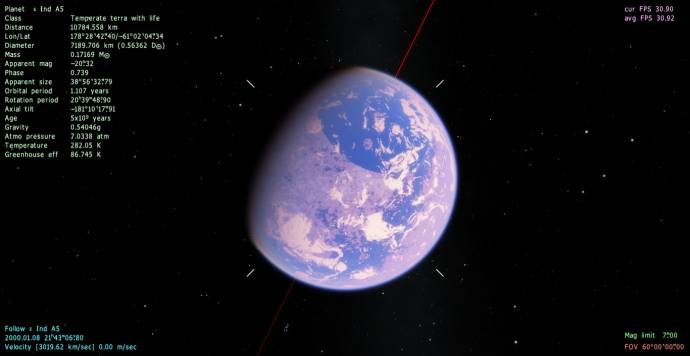
Quote (apenpaap) I doubt humans will be a cloud of nanobots by the 26th century, really. Perhaps in the distant future, but 2500 seems far too soon for it.
and still , do contact lenses, pacemaker, etc change the humans as something not even really human? no but it was a big technological advancement. I agree nanotechnologie is much more advanced but human is a adaptable specie, so in the future we will change for sure, but I dont think that having nanorobot in our blood made us less human and more something else.
Quote (DoctorOfSpace) If the year is 2500 why do humans even need to breathe oxygen?  I really think that humans are attached to their original habitat and to their nature (and will be even more when that habitat will be rare) It's part of us to breathe air, eat, to have foot on land, etc.. and I do not think they want to abandon it so early(2500), or ever. Of course one day , evolution will surely overtake us but not in 500 years. I really think that humans are attached to their original habitat and to their nature (and will be even more when that habitat will be rare) It's part of us to breathe air, eat, to have foot on land, etc.. and I do not think they want to abandon it so early(2500), or ever. Of course one day , evolution will surely overtake us but not in 500 years.
Quote (apenpaap) One of them are the constant blazing hot winds coming from the daylit side, which could be warm enough to be dangerous
Edited by Solaris - Sunday, 24.06.2012, 17:27 |
| |
| |
| HarbingerDawn | Date: Sunday, 24.06.2012, 16:39 | Message # 8 |
 Cosmic Curator
Group: Administrators
 United States
United States
Messages: 8717
Status: Offline
| Quote (apenpaap) the 2 atmosphere pressure means all winds would be twice as strong as an Earth wind of the same speed
Solaris, I don't have that planet in my SE because I have StarProcBifurcation turned off (it was generating too many false binary systems for my liking). EPS Indi is not a binary star in reality, at least not the way that SpaceEngine generates it. It does have companions, but they are small binary brown dwarfs ~1500 AU from the star, so for all practical purposes it is a single-star system.
All forum users, please read this!
My SE mods and addons
Phenom II X6 1090T 3.2 GHz, 16 GB DDR3 RAM, GTX 970 3584 MB VRAM
|
| |
| |
| Solaris | Date: Sunday, 24.06.2012, 17:18 | Message # 9 |
 World Builder
Group: Global Moderators
 France
France
Messages: 731
Status: Offline
| Aw, I've not made the connection between Epsilon Indi and this thread http://en.spaceengine.org/forum/8-644-1#5406 
Edited by Solaris - Sunday, 24.06.2012, 17:19 |
| |
| |
| DoctorOfSpace | Date: Sunday, 24.06.2012, 17:41 | Message # 10 |
 Galaxy Architect
Group: Global Moderators
 Pirate
Pirate
Messages: 3600
Status: Offline
| Quote (Solaris) why do they want to stop breathing air. happy I really think that humans are attached to their original habitat and to their nature (and will be even more when that habitat will be rare) It's part of us to breathe air, eat, to have foot on land, etc.. and I do not think they want to abandon it so early(2500), or ever. Of course one day , evolution will surely overtake us but not in 500 years.
Because everyone in this thread could still be alive by the 2500s. Not kidding either, the technology being developed now will be correcting problems faster than they occur within this century so human life expectancy will drastically increase. If you no longer breathe air then you no longer require things like oxygen to survive and thus you can live anywhere as long as it has a source of energy to sustain you. Breathing isn't really a habit but rather a function of life that has to be sustained or else the organism, in this case us, dies. If you remove the requirement to breathe and eat and replace cells with nanobots that can draw energy from their surrounding environment you create a far more efficient organism.
http://www.youtube.com/watch?v=HMYVH-hBGWg
The 2500s aren't too soon, they're actually a bit late to the punch in terms of human evolution.
Intel Core i7-5820K 4.2GHz 6-Core Processor
G.Skill Ripjaws V Series 32GB (4 x 8GB) DDR4-2400 Memory
EVGA GTX 980 Ti SC 6GB
|
| |
| |
| Solaris | Date: Sunday, 24.06.2012, 18:57 | Message # 11 |
 World Builder
Group: Global Moderators
 France
France
Messages: 731
Status: Offline
| This is interresting, Indeed the technology is developing more and more quickly, and the range of opportunity to come are more varied than ever. But you see, if today you give me the chance to have one of these far more efficient organism you talking about, i will refuse it. I love breath air , eat , being sick, tired, cold , hot.. that make me feel alive.
I agree that technology will influence our evolution, but this will raise some issues , if the changes are naturals , in a long period, there is no problem, but if they are provoked, on a very short lapse of time that's another story. A moral one.
anyway that's my opinion.
|
| |
| |
| Aerospacefag | Date: Wednesday, 04.07.2012, 18:22 | Message # 12 |
 Pioneer
Group: Users
 Russian Federation
Russian Federation
Messages: 401
Status: Offline
| Here are two candidates i found recently.
1. Cool terra with habitable environment on its day side - because it's actually tidal locked, I suppose it would be comfortable to live here. And its ice cap rises above cloud level (except some big craters on the dark side), which is quite interesting. Only 3,5 pc, and moreover, it is rotating around bright brown dwarf.


2. Almost like Earth, but the air pressure is a bit low. Flat and uninteresting world with patchy geography, I can see nothing special here. 17 pc from Earth - most likely there' are also many other worlds like this.

Edited by Aerospacefag - Wednesday, 04.07.2012, 18:23 |
| |
| |
| SpaceEngineer | Date: Wednesday, 15.08.2012, 13:52 | Message # 13 |
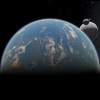 Author of Space Engine
Group: Administrators
 Russian Federation
Russian Federation
Messages: 4800
Status: Offline
| Tau Ceti 3 (however, this is 0.96 version).
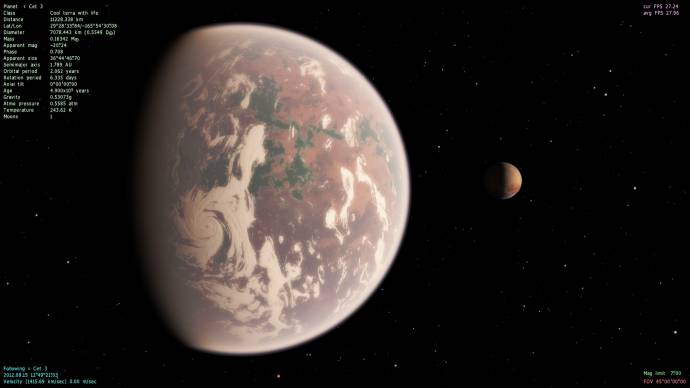

|
| |
| |
| LordHaHa | Date: Friday, 21.09.2012, 10:45 | Message # 14 |
 Space Tourist
Group: Users
 United States
United States
Messages: 23
Status: Offline
| Quote (apenpaap) I don't know, really. I do know a third of a bar is roughly the point where a human can't adjust to the low pressure any more and suffocates (which causes the 'death zone' at the tops of the Himalayas). If you suddenly entered a place with 2 bar it would probably be very dangerous, but I'm guessing you could probably live in it if you adjusted slowly, but by bit (say, on the long journey there). I don't know what would be the maximum pressure you could adjust to, but I'd guess it's probably less than 10 bar.
That's about right. I did some research into this a while back when making my own planetary rating system. About 0.4 ATM is about where you will die eventually from lack of pressure (not immediately though, over many hours), and 0.25 ATM is the point where you must have at least a partial pressure solution to keep going.
Going up, 1-2 ATM is generally OK. Interestingly your air consumption increases with the pressure. So do the neurological effects. You do dumber things in higher pressures, but up to about 4 ATM you can survive without equipment so long as you don't "Darwin Award" yourself. By about 6 ATM you really start losing it mentally, and 9-10 ATM is the physical limit. If you are on "mixed" air you can go a bit beyond even these points, but it starts getting iffy fast after 11 ATM without a suit and not much after that without a vehicle. Of course you should probably be on a mix at pressures a little over 2 ATM if you want to keep straight, which is usually a good idea on an alien world.
Its a chuckle everytime I scan a Terra with life...and then see that the atmospheric pressure is 1000 ATM (or, sometimes, 0.1 ATM).
LordHaHa
Edited by LordHaHa - Friday, 21.09.2012, 10:48 |
| |
| |
| neutronium76 | Date: Friday, 21.09.2012, 11:54 | Message # 15 |
 World Builder
Group: Users
 Greece
Greece
Messages: 718
Status: Offline
| Quote (Aerospacefag) Almost like Earth, but the air pressure is a bit low. Flat and uninteresting world with patchy geography, I can see nothing special here. 17 pc from Earth - most likely there' are also many other worlds like this.
This could be a canditate for an earth twin! However for this quest it woud probably be too far away: 17pcx3.262ly= 55.5 ly / 0.5c = 111 years travel time . A life extension technology would be required.
PC1:Core i7 970@3.34GHz, 6 cores/12 threads, 12GB DDR3 RAM@1.34GHz, 2x(SLI) GTX-580 GPUs 3GB VRAM(GDDR5)@1GHz, OS:Win7x64SP1
PC2:Core2Quad X9770@3.2GHz, 2 cores/4 threads 4GB DDR2 RAM@1GHz, GTX-285 GPU 1GB VRAM(DDR3)@1.24GHz, OS:WinVistax64SP2
Edited by neutronium76 - Friday, 21.09.2012, 11:55 |
| |
| |